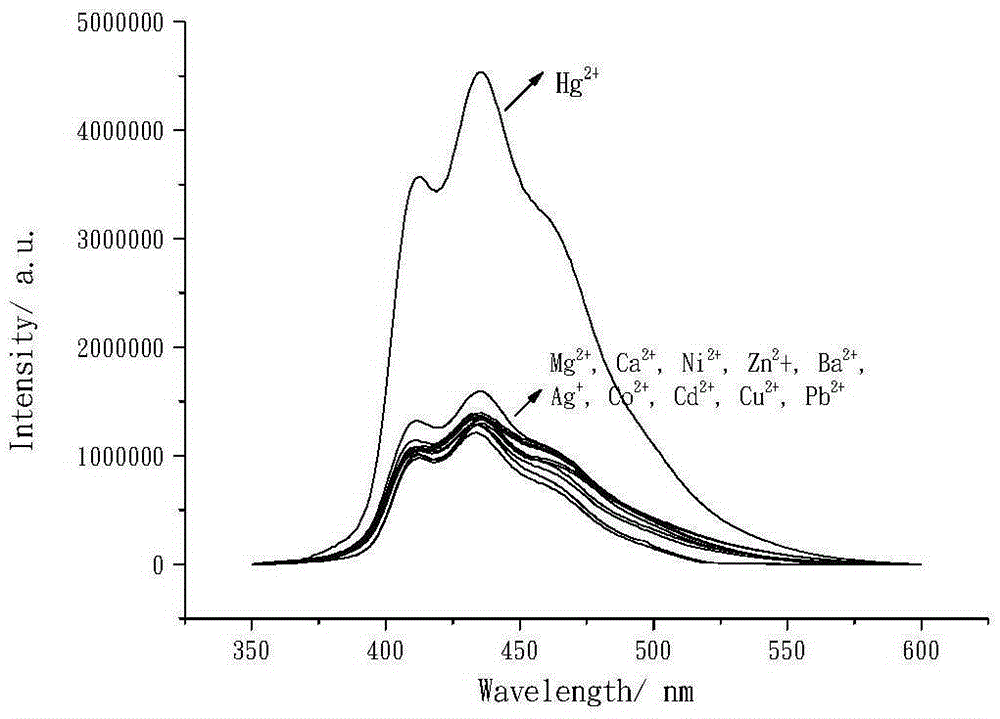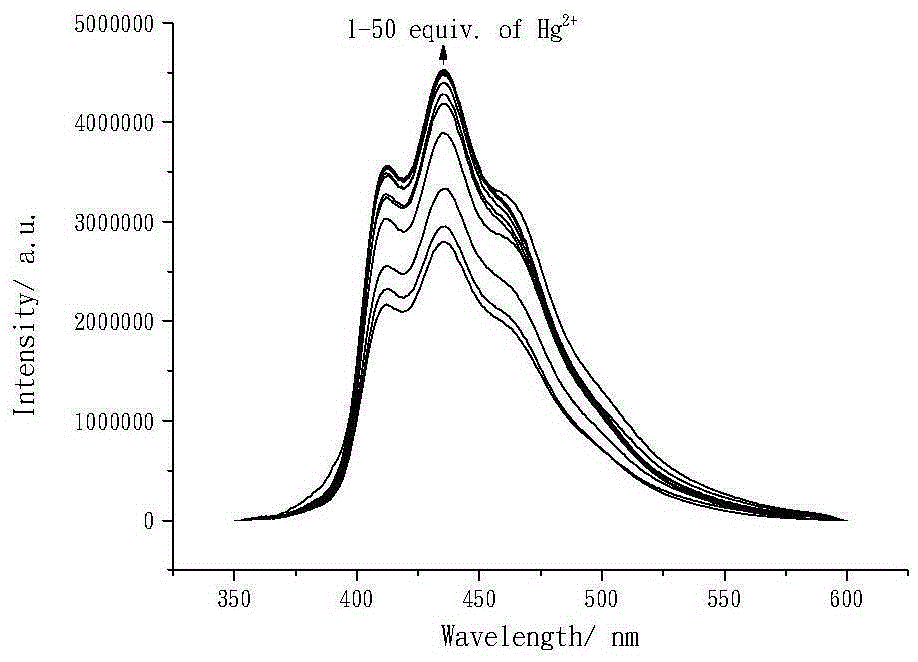Preparation method and application of fluorescent probe
A fluorescent probe and fluorescent sensing technology, applied in the field of chemical sensing materials, achieves the effects of simple post-reaction processing, reduced detection cost, and mild reaction conditions
- Summary
- Abstract
- Description
- Claims
- Application Information
AI Technical Summary
Problems solved by technology
Method used
Image
Examples
Embodiment 1
[0030] A kind of preparation method of fluorescent probe, such as figure 1 In the synthetic route shown, 180 mg of carbohydrazide and 861 mg of hydroxyanthral are dissolved in 44 mL of ethanol / water = 10:1 mixed solution of 1 mL of glacial acetic acid, stirred and refluxed at a medium speed at 80 ° C for 12 hours, and the reaction solution After high-speed centrifugation, the precipitate was washed with anhydrous methanol. The yield is 99%, and it is named as the Schiff base fluorescent sensing material.
[0031] An application method of a fluorescent probe, the specific steps are as follows:
[0032] Step 1, the Schiff base fluorescent sensing material is prepared into C=1×10 with DMF -5 mol / L Schiff base fluorescent sensing material dispersion.
[0033] Step 2. Prepare Hg 2+ A solution having a molar ratio of 0.5, 1, 2, 5, 10, 20, 30, 40, 50 to the Schiff base fluorescent sensing material; mixing the dispersion prepared in step 1 with the solution respectively to obtain ...
Embodiment 2
[0040] Preparation of Schiff base fluorescent sensing material: Dissolve 360mg of carbohydrazide and 1.812g of hydroxyanthral in 50mL mixed solution of ethanol / water=8:1 dispersed with 5mL of glacial acetic acid, stir and reflux at a medium speed at 90°C After 10 hours, the reaction solution was centrifuged at high speed, and the precipitate was washed with anhydrous methanol. Yield 96%.
[0041] An application method of a fluorescent probe, the specific steps are as follows:
[0042] Step 1, the Schiff base fluorescent sensing material is prepared into C=1×10 with DMF -5 mol / L Schiff base fluorescent sensing material dispersion.
[0043] Step 2. Prepare Hg 2+ A solution having a molar ratio of 0.5, 1, 2, 5, 10, 20, 30, 40, 50 to the Schiff base fluorescent sensing material; mixing the dispersion prepared in step 1 with the solution respectively to obtain a mixed solution; Measure the fluorescence intensity value of the mixed solution. Measure the change of the fluorescen...
Embodiment 3
[0051] Preparation of Schiff base fluorescent sensing material: Dissolve 120mg of carbohydrazide and 618mg of hydroxyanthral in 40mL mixed solution of ethanol / water=9:1, stir and reflux at medium speed at 95°C for 12 hours, and the reaction solution is passed through high speed Centrifuge, and wash the precipitate with anhydrous methanol. Yield 94%.
[0052] An application method of a fluorescent probe, the specific steps are as follows:
[0053] Step 1, the Schiff base fluorescent sensing material is prepared into C=1×10 with DMF -5 mol / L Schiff base fluorescent sensing material dispersion.
[0054] Step 2. Prepare Hg 2+ A solution having a molar ratio of 0.5, 1, 2, 5, 10, 20, 30, 40, 50 to the Schiff base fluorescent sensing material; mixing the dispersion prepared in step 1 with the solution respectively to obtain a mixed solution; Measure the fluorescence intensity value of the mixed solution. Measure the change of the fluorescence intensity value of the mixed solutio...
PUM
 Login to View More
Login to View More Abstract
Description
Claims
Application Information
 Login to View More
Login to View More - R&D
- Intellectual Property
- Life Sciences
- Materials
- Tech Scout
- Unparalleled Data Quality
- Higher Quality Content
- 60% Fewer Hallucinations
Browse by: Latest US Patents, China's latest patents, Technical Efficacy Thesaurus, Application Domain, Technology Topic, Popular Technical Reports.
© 2025 PatSnap. All rights reserved.Legal|Privacy policy|Modern Slavery Act Transparency Statement|Sitemap|About US| Contact US: help@patsnap.com



